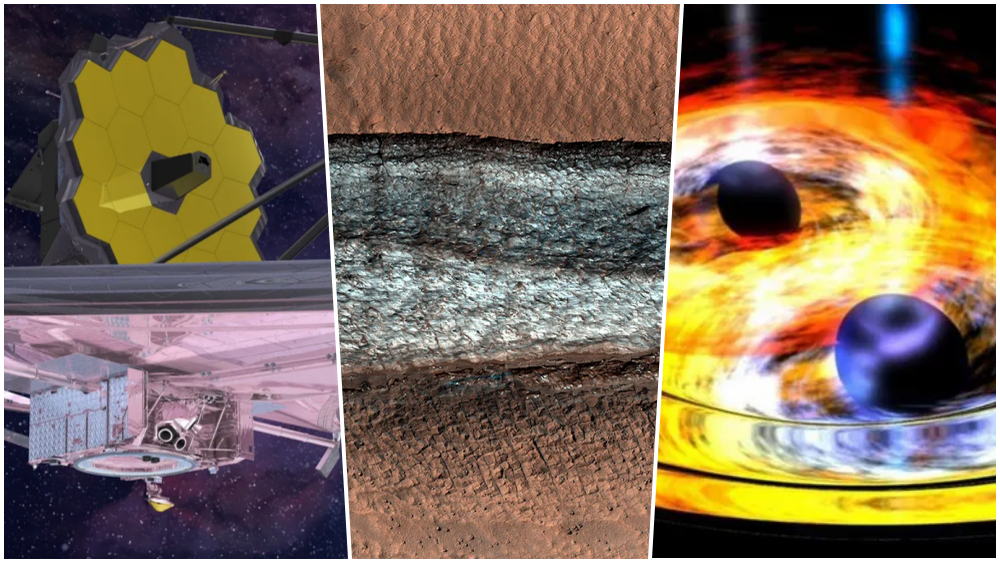The sky is not the limit! | JWST notes, ice on Mars, black holes and +!
4 min read

If the James Webb Telescope surprised some astronomers with its results, others are intrigued, to say the least. Distant galaxies found by the instruments may actually be much closer than you think. One researcher explained how they were confusing their colleagues, and you can see that below.
Other news this week includes an ice cliff exposed on Mars’ surface, supermassive black holes about to collide, and more.

Some measurements of distant galaxies based on data from the James Webb Telescope confuse astronomers. He looks at things he’s never seen before, located at greater distances… far away.
Garth Ellingworth, an astronomer at the University of California, is one of those who think these results are outside the models’ expectations. He wonders how galaxies formed in such an early universe, and suspects that they may in fact be nearby galaxies with a large amount of dust. This dust can absorb blue light, which leads to miscalculations of its distances. At the moment, this mystery is still open.

A new image from the Mars Reconnaissance Orbiter (MRO) has revealed a prominent cliff covered in exposed ice. This is only possible because there is less solar radiation in the area where the cliff is located, thus keeping the water in a solid state.
The team still doesn’t know exactly how long it took for the ice to build up there, but the bands indicate layers of ice that formed under different atmospheric conditions.

A galaxy called SDSS J1430+2303, relatively close to the Milky Way (about a billion light-years away) appears to have a binary system of supermassive black holes at its core. According to a new study, they could collide three years from now, a negligible amount of time on a cosmic scale.
The combined mass of the two black holes at the center of SDSS J1430+2303 will be 200 million suns, and they both orbit each other at a very close distance. This is important for scientists, because it was not possible to trace such a catastrophic event.

Scientists often look for flaws or loopholes in Albert Einstein’s general theory of relativity to decipher unsolved mysteries. One of them is dark energy, which is responsible for the accelerating expansion of the universe, which is pushing galaxies further and further apart. How does this happen if gravity should attract things?
In this test, a group of researchers measured more than 100 gravitational lenses, hoping to find some deviation from Einstein’s predictions. The result, as I noticed, was negative. Einstein was right again. But physicists aren’t giving up any time soon, especially with upcoming gravitational wave detectors.

Rocket Lab is developing a mission to Venus, expected to launch in May 2023. If all goes well, it will be the first commercial mission sent to the neighboring planet.
The goal is to carry a probe weighing about 20 kilograms, fitted with a heat shield to protect it from high temperatures, and an instrument that studies the planet’s clouds with an ultraviolet nefilter scale, looking for organic particles in Venus’s atmosphere.

A group of scientists has identified and mapped more than 3 million individual stars in the galactic core, in a region called Sagittarius B1. These are very young stars that ionize the surrounding gases, i.e. rip electrons from gases like hydrogen.
Most of them did not form in huge groups, but in groups of stars devoid of gravity from each other, following the same path. The researchers suggest that star formation began in the innermost region of the center and then spread to the outer regions.
Orbit Fab startup is developing a supply system in space, in Earth orbit, and plans to put the plan into action from 2025. The idea is to ship US$20 million for up to 100kg of fuel for satellites, in the case of hydrazine.
This is the first time the company has set a price for fuel, hence the importance of the ad, which will help potential customers better understand how fuel economy works.
Read also:

“Musicaholic. Thinker. Extreme travel trailblazer. Communicator. Total creator. Twitter enthusiast.”



